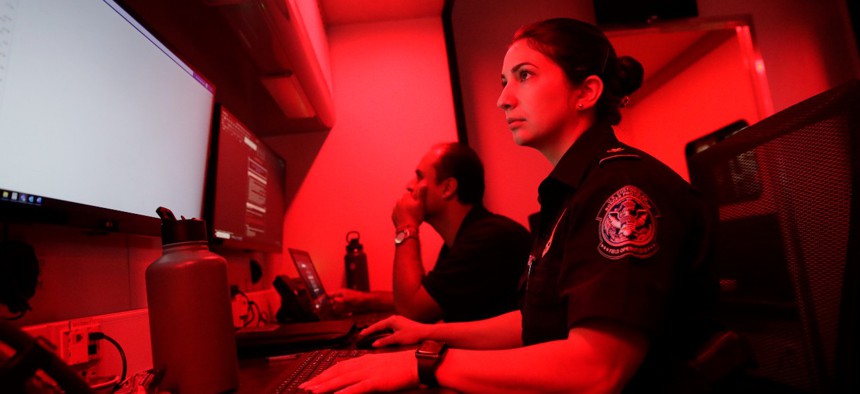The largest law enforcement agency in the nation pledges to hire a lot more women

U.S. Customs and Border Protection officers with the Office of Field Operations conduct oversight operations at the Region IV Emergency Operations Center in Doral, Fla., on Sept. 29. Glenn Fawcett / CBP
The agency has a long way to go to fulfill its new commitment.
Customs and Border Protection became the second federal agency to commit to ensuring at least 30% of its annual recruit class by 2030 is female, calling its pledge an “ambitious but worthwhile goal.”
CBP noted it has a long way to go to meet the target as it joined more than 200 state, local and federal agencies to make the commitment. The organization leading those entities is known as the 30X30 Initiative. With more than 64,000 employees, CBP is the largest law enforcement agency in the country.
The agency declined to say in time for publication of this story the current makeup by gender of its recent recruiting classes, though previously released data showed it has hovered around 20% in recent years for front-line, entry-level law enforcement positions. According to data maintained by the Office of Personnel Management, about 22% of all current CBP employees are female. Of the 50,000 in “investigative” positions, just 16% are female.
“We have made some progress in recruiting women to join CBP as law enforcement officers and agents, but there is an incredible amount of work still to be done,” CBP Commissioner Chris Magnus said. “Our pledge to join 30x30 is part of a larger framework for our agency to improve the recruitment, retention, representation and experiences of women officers and agents. Working with 30x30 will also help us identify, understand, and address the obstacles in recruiting and retaining more women in law enforcement positions.”
According to the larger 30X30 Initiative, female law enforcement officers are less likely to use excessive force, are named in fewer complaints, provide better outcomes for victims of sexual assault and make fewer discretionary arrests overall. Across the country in 2021, the initiative found women made up just 12% of sworn officers and 3% of police leadership.
The organization has some federal roots; the initiative was stood up as a result of a summit hosted by the National Institute of Justice, a research agency within the Justice Department. Maureen McGough, a former senior policy advisor at the institute, co-founded the organization with Ivonne Roman, the former chief of the Newark Police Department in New Jersey.
As part of the pledge, CBP will have to share its progress toward reaching the 30% mark with the initiative. That will include both its “stumbling blocks” and its “victories” as part of an effort to develop best practices and lessons learned for the law enforcement community. The initiative plans to build out programs to address barriers to women’s advancement in law enforcement.
Last month, the U.S. Marshals Service became the first federal agency to join the pledge. USMS also did not share the gender breakdown for its latest recruit class, but about one-third of its more than 5,000 employees are female. For the 3,600 in investigative positions, however, just 14% are female. USMS said across the entire Justice Department, 16% of criminal investigators were female as of 2018.
“We know diversity brings value and more women in law enforcement will strengthen law enforcement and make us responsive to the diverse needs of our communities,” said Ronald David, USMS director. “We look forward to this collaboration that will help us improve our organization and better equip us to respond to the challenges of the future.”
McGough at the time called it a "huge step" to include a federal agency in the initiative and predicted that additional federal offices would follow suit.
CBP said it joined the initiative as part of a larger effort to boost its diversity, equity and inclusion. In a report CBP issued last year, officials highlighted that the bureau is creating specific workforce recruiting events, a marketing and advertising plan, and a data analytics initiative all aimed at boosting women in front-line law enforcement positions. In that report, CBP said 18% of its new, front-line, entry-level hires in fiscal 2020 were women. That marked a slight decrease from the 20% of hires CBP averaged in the preceding five years. Among new Border Patrol agents, just 8% of hires were female in 2020.
CBP said its 30X30 commitment would ensure “its ranks are not only more reflective of the people it serves, but also an inclusive working environment overall.”






